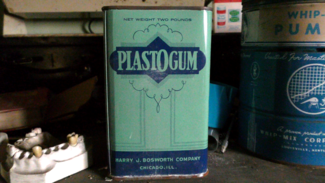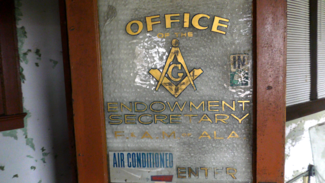Colored Masonic Temple
The Colored Masonic Temple (officially the Masonic Temple Building) is an 8-story Renaissance-Revival style building located at 1630 4th Avenue North. It was constructed for the Most Worshipful Prince Hall Grand Lodge, Free & Accepted Masons of Alabama and is a contributing structure to the 4th Avenue Historic District. The building was developed under the leadership of Grand Master Walter Woods and the $750,000 cost was funded entirely by contributions, without taking on any construction debt.
The brick building was designed by the firm of Taylor & Persley (Robert Robinson Taylor and Louis Hudson Persley), and built by Windham Brothers Construction. The cornerstone was laid in 1922 and the building opened on April 1, 1924. Its design features an engaged limestone temple front on the south facade. The architrave and frieze of the Corinthian entablature was segmented to make room for the fourth-floor windows. The dentil cornice is continuous, and wraps two sides of the building, dividing the upper and lower sections. The upper part of the facade is gridded off into two and 1 1/2-story sections, separated by pilasters and smaller entablatures.
Throughout its history the building has housed the offices of notable African-American professionals, businesses and organizations, and a popular drug store and soda fountain on the ground floor. Its auditorium, with a capacity of 2,000, was used for meetings, ceremonies, concerts, dances, cotillions, mass meetings and other special events. The Duke Ellington Orchestra and Count Basie's big bands played regularly in the Temple ballroom.
In October 1932 the auditorium hosted an All-Southern Scottsboro and Civil Rights Conference organized by the Communist Party-affiliated International Labor Defense. Speakers included Donald and Alice Burke, Mary Leonard and Ben Fowler. Most of the hundreds of people who came to participate were turned away by a police intimidation.
The Alabama NAACP held a meeting to reorganize in the Auditorium in the 1930's.
Three ground floor rooms were used for the Booker T. Washington Library, the first public lending library open to Black citizens in Birmingham. The offices of the NAACP, in this building, were padlocked following the May 26, 1956 order by Montgomery Circuit Judge Walter Jones banning the organization from operating in the state of Alabama.
Around the 1990's, problems began to arise with HVAC systems and funds to keep the Temple operational. Around 2011, all tenants had moved out entirely, and the building shuttered and left dormant. In the 2010's, space in the hallway by the Masonic Auditorium was damaged by fire, suspected to be from squatter activity. The Temple was fitted with a security system to aid in protection of the structure.
It is still used for meetings of the the Prince Hall Grand Lodge, but is otherwise underutilized.
Redevelopment proposals
In January 2009 Main Street Birmingham hosted a workshop at the building to generate ideas for creative redevelopment. A campaign to raise $10-15 million for restoration and expansion of the Temple Building was launched by the Grand Lodge in 2017, shortly after it was made part of the Birmingham Civil Rights National Monument. Schemes for possible expansion discussed at the time included a multi-story parking deck to the west of the Temple with retail spaces on the ground floor.
In November 2019 The Lodge announced that it was working with Historic District Developers (a venture of Henderson & Co. of Raleigh-Durham, North Carolina with Direct Invest Development LLC of New York) on a $29 million mixed-use redevelopment of the building. Urban Impact Inc. and the Birmingham Department of Innovation and Economic Opportunity also participated in the project, which was intended to qualify for Historic Preservation Tax Credits, New Market Tax Credits, and Opportunity Zone tax credits.
Plans for the building include incubator retail, maker-space and office space. The project's design phase continued into 2022, with the start of construction planned for late that year.
The unique history of the Colored Masonic Temple building was preserved extraordinarily by the closing and dormancy of the building. Prior to renovations beginning in 2022, a time capsule of life in Birmingham for African Americans from 1924 on to the 1990's survived, including fully furnished and stocked dental offices from the 1930's and 1950's, Masonic meting halls stacked with boxes of records and regalia dating as far back as the 1920's, artifacts from the Civil Rights era, and dozens of file cabinets filled with paperwork from the operations of the Most Worshipful Prince Hall Grand Lodge and all affiliates in Alabama during the 20th century. These artifacts are being processed and catalogued by the Lodge for preservation and historical significance during the 2022 revitalization effort.
Tenants
- basement: Temple Bowling Center for Colored People bowling lanes (1941)
- lobby: Ford & Campbell Jeweler (1941), Lillie Robinson florist (1941),
- ground floor: Booker T. Washington Library (1924-1956)
- Birmingham Plumbing Company (1926)
- Your Flower Shop florist (2000's)
- Simp's Barber and Style Shop men's barber shop (2000's)
- John's Alterations and Repair (2000's)
- Esquire's Shoe Shine and Repairs cobbler (2000's)
- Temple Pharmacy (1940's)
- 2nd floor:
Masonic Auditorium
- 3rd floor
- 301-303: Ferdinand Bradford, physician (1941)
- 304-307: Jefferson County Colored Schools (1941)
- Jackson's Dental Lab dental prosthetic laboratory
- Mercedes Entertainment
- 4th floor
- 401-403: Eugene Elliott dentist & Charles McPherson physician (1941)
- 404: American Federation of Musicians Local 733 (1941)
- 405-408: Dr. L.U. Goin physician and Grand Medical Registrar (1926)
- 405: Mattie Moreland dressmaker (1941)
- 407-408: John J. Thompson dentist (1941)
- 431: Masonic Library Supplies and Masonic Church Supplies
- Birmingham Housing Authority Offices of Benjamin Greene
- NAACP meeting halls
- Masonic meeting halls
- 5th floor
- Dr. R.M. Howard dentist (1960's-1990's)
- Dr. B.M. Jefferson dentist (1930's-1970's)
- Dr. F.E. Jamison dentist
- Heroines of Jericho
- Alabama State Coordinating Association for Registration and Voting, 9th Congressional District
- 501-504: Marion McCall & Samuel Harris physicians (1941)
- 503: Colored Fair Association (1928)
- 505-506: Herman Clayborne dentist (1941)
- 507-508: John Hutchinson physician (1941)
- 510-512: Arthur Shores attorney & Hollins & Shores real estate (1941)
- 523-528: Birmingham Reporter newspaper (1930–1932)
- 525-527: American Cross Chemical Company (1926)
- 525: Stauffer Colored Salon beauty shop (1940's)
- 529-530: Cooperative Life & Hospital Insurance Co. (1941)
- 6th floor
- 601-606: Atlanta Life Insurance Co. (1941)
- T.L. Crowell accountant
- Morris and Lavette, P.C. attorneys
- 607-612: Pilgrim Health & Life Insurance Co. (1941)
- 613-614: Red Cross Consistory No. 2 Royal Arch Masons, Khedive Temple No. 16 Ancient Free & Accepted Masons, Thera Chapter No. 4 Order of the Eastern Star, Day Myrtle Chapter No. 104 Order of the Eastern Star, Tellers Success Chapter American Krusaders, Erwin Success Chapter No. 381 Order of the Eastern Star, Silver Queen Chapter No. 58 Order of the Eastern Star, Evening Star Chapter No. 578 Order of the Eastern Star, Zerubbabel Chapter No. 3 Royal Arch Masons, Mt Nebo Lodge No. 463 Ancient Free & Accepted Masons, Geometry Lodge No. 410 Ancient Free & Accepted Masons, Owens Delight Council No. 387 American Krusaders, Mizpah Chapter No. 194 Order of the Eastern Star, Loving Progress Chapter No. 518 Order of the Eastern Star, Knights of Tabor No. 30, Pride Ruth Chapter American Krusaders, Superior Chapter No. 34 Order of the Eastern Star, True Friend Chapter No. 627 Order of the Eastern Star, Beulah Star Chapter No. 418 Order of the Eastern Star, Terrell's Chapter No. 562 Order of the Eastern Star, Naomi Chapter No. 385 Order of the Eastern Star, Occidental Lodge No. 31 Ancient Free & Accepted Masons, Triune Lodge No. 430 Ancient Free & Accepted Masons, Woods Joy Lodge No. 752 Ancient Free & Accepted Masons (1941)
- 626-630: Atlanta Life Insurance Co. agents' rooms (1941)
- 7th floor
- 701-704: Ernest Taggart dentist (1941)
- 705-706: Charles Hendley attorney
- Most Worshipful Grand Lodge (Prince Hall) Ancient Free & Accepted Masons (1941)
- 707-714: Ancient Free & Accepted Masons of Alabama endowment office (1926–1941)
- 711: Fred Jenkins accountant (1941)
- 715-720: North Carolina Mutual Life Insurance Co. (1941)
- 727-728: Black Eagle Detective Agency & J. J. Israel Advertising Agency (1941)
- 729-730: Henry Guin dentist (1941)
References
- Polk's Birmingham (Jefferson County, Ala.) City Directory, including Fairfield and Homewood (1941) Richmond, Virginia: R. L. Polk & Co.
- Ruisi, Anne (January 12, 2009) "Masonic Temple in downtown Birmingham draws preservationists." The Birmingham News
- Weiss, Ellen (2012) "Robert R. Taylor and Tuskegee: An African-American Architect Designs for Booker T. Washington." Montgomery: New South Books ISBN 1588382486
- Edgemon, Erin (February 26, 2017) "Historic civil rights landmark launches fundraising campaign." The Birmingham News
- Van der Bijl, Hanno (November 20, 2019) "Developer eyes mixed-use project at Masonic Temple in city center." Birmingham Business Journal
- Watson, Nathan (February 14, 2022) "$29M renovation underway for Masonic Temple Building." Bham Now
External links
- Grand Lodge History at mwphglofal.org
- AL-Colored Masonic Temple Project at gofundme.com
- [1] Full video tour of the Colored Masonic Temple building in its closed down state prior to 2022 renovations. Video by Austin H. Stone.






